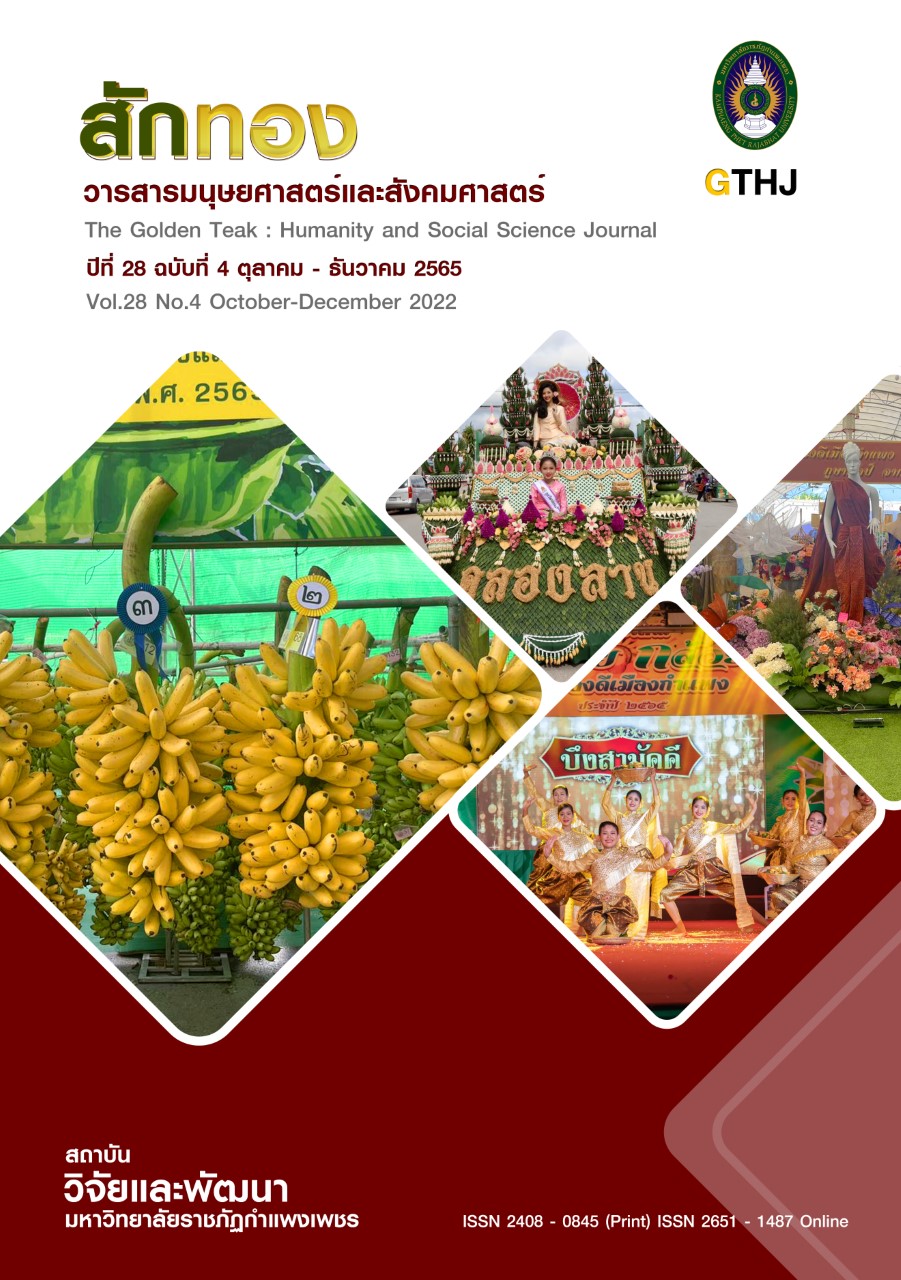A Study of Graduate Students' Enrollment Decisions, Satisfaction, and Needs towards Learning Experiences
Main Article Content
Abstract
This study aims to investigate factors influencing students’ decision-making on pursuing graduate studies, satisfaction with learning experiences at universities, and the needs of learning experience management for graduate studies. A sequential explanatory mixed-methods design was conducted. The 2019 Student Barometer dataset was investigated with descriptive statistics for the quantitative phases. This dataset was the result of a survey on the learning experiences of 115,807 graduate students in 66 countries around the world (e.g., Thailand, Canada, and China) conducted in 2019 using the Student Barometer instrument. Among these students, 6,118 students were studying at Thai universities. A qualitative phase was then conducted: 30 Thai students who had answered the survey in the quantitative phase were interviewed and analyzed the data by content analysis. Quantitative results: for the decision on pursuing graduate studies, the majority of Thai (97.0%) and international (95.7%) students emphasized on academic degrees that would affect their future work. In addition, Thai students (95.3%) were satisfied with their learning experience in graduate courses, and Thai students (89.0%) were likely to recommend others to apply to the universities where they were studying, which is higher than international students. Qualitative results: needs promoting overall satisfaction with universities could be categorized into four domains: 1) arrival, 2) learning, 3) living, and 4) support.
Article Details

This work is licensed under a Creative Commons Attribution-NonCommercial-NoDerivatives 4.0 International License.
บทความที่ได้รับการตีพิมพ์เป็นลิขสิทธิ์ของวารสาร สักทอง : วารสารมนุษยศาสตร์และสังคมศาสตร์ สถาบันวิจัยและพัฒนา มหาวิทยาลับราชภัฏกำแพงเพชร
ข้อคิดเห็นใดๆ ที่ปรากฎในวารสารเป็นวรรณกรรมของผู้เขียนโดยเฉพาะ ซึ่งมหาวิทยาลัยราชภัฏกำแพงเพชรและบรรณาธิการไม่จำเป็นต้องเห็นด้วย
References
Al-Fattal, A. (2010). Understanding student choice of university and marketing strategies in Syrian private higher education. Doctor of Philosophy, University of Leeds.
Agasisti, T. & Catalano, G. (2006). Governance models of university systems—towards quasi-markets? Tendencies and perspectives: A European comparison. Journal of Higher Education Policy and Management, 28(3), 245-262.
Ammigan, R. & Jones, E. (2018). Improving the student experience: Learning from a comparative study of international student satisfaction. Journal of Studies in International Education, 22(4), 283-301.
Athiyaman, A. (1997). Linking student satisfaction and service quality perceptions: The case of university education. European journal of marketing, 31(7), 528-540.
Baran, B.E. & Woznyj, H.M. (2021). Managing VUCA: The human dynamics of agility. Organizational Dynamics, 50(2), 1-11.
Brett, K.J. (2013). Making the Most of Your International Student Barometer Data: A Guide to Good Practice. [Online]. Available : https://aei.gov.au/research/Publications/Pages/ Default.aspx [2020, June 30].
Creswell, J.W. & Clark, V.L.P. (2018). Designing and conducting mixed methods research. (3 nd ed.). CA : Sage Publications.
Creswell, J.W. & Miller, D.L. (2000). Determining validity in qualitative inquiry. Theory into Practice, 39(3), 124-130.
Eckel, P. (2007) Redefining competition constructively: The challenge of privatization, competition, and market-based state policy in the United States. Higher Education Management and Policy, 19(1), 1-17.
Ellis, S.E. (2011). Strategic Planning in Student Affairs: New Directions for Student Services, Number 132 (Vol. 109). San Francisco: John Wiley & Sons.
Gruber, T., Fuß, S., Voss, R. & Gläser-Zikuda, M. (2010). Examining student satisfaction with higher education services: using a new measurement tool. International Journal of Public Sector Management, 23(2), 105-123.
Hartung, P.J. (2013). The Life-Span, Life-Space Theory of Careers. In S.D. Brown & R.W. Lent (Eds.), Career Development and Counseling: Putting Theory and Research to Work (2 nd ed., pp. 83-113). Hoboken, NJ : Wiley.
Helgesen, Ø., & Nesset, E. (2007). Images, satisfaction and antecedents: Drivers of student loyalty? A case study of a Norwegian university college. Corporate reputation review, 10(1), 38-59.
I-graduate. (2019). International Student Barometer. [Online]. Available : www.intouch.i-graduate.org [2019, April 23].
Kasemchaiyanandh, T. & Sumettikul, P. (2013). Marketing Management Strategies for Graduate Programs of Higher Education Institutes. EAU Heritage Journal, 3(2), 173-181.
Klink, R.R. (2003). Creating meaningful brands: The relationship between brand name and brand mark. Marketing Letters, 14(3), 143-157.
Levy, D. (2006). Market university?. Comparative Education Review, 50(1), 113-124.
Pedro, E., Mendes, L. & Lourenço, L. (2018). Perceived service quality and student's satisfaction in higher education: the influence of teaching methods. International Journal for Quality Research, 12(1), 165-192.
Philiastides, M.G. & Ratcliff, R. (2013). Influence of branding on preference-based decision making. Psychological science, 24(7), 1208-1215.
Prugsamatz, S., Pentecost, R. & Ofstad, L. (2006). The influence of explicit and implicit service promises on Chinese students’ expectations of overseas universities. Asia Pacific Journal of Marketing and Logistics, 18(2), 129-145.
Sallis, E. (2002). Total Quality Management in Education. London : Kogan Page.
Savickas, M.L. (2011). New questions for vocational psychology: Premises, paradigms, and practices. Journal of Career Assessment, 19(3), 251-258.
Shue, C.M. & Falahat, M. (2017). An integrated model of perceived quality in the brand performance of higher education institution. Advanced Science Letters, 23(4), 3148-3150.
Super, D.E. (1980). A life-span, life-space approach to career development. Journal of Vocational Behavior, 16(3), 282-298.
Woodall, T., Hiller, A. & Resnick, S. (2014). Making sense of higher education: Students as consumers and the value of the university experience. Studies in Higher Education, 39(1), 48-67.


